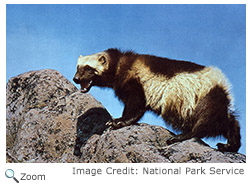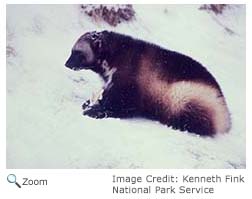Wolverine - Gulo gulo |
|||||||||
Description  Some wolverines have patches of silver to yellowish fur over their eyes and on the crown of their heads. The wolverine has a keen sense of smell and hearing and relatively poor eyesight. It has large, strong teeth and powerful jaws that help it rip frozen meat from carrion. It also has powerful legs with padded feet and large claws. Its padded feet help it walk in the snow! Males are larger than females. Some wolverines have patches of silver to yellowish fur over their eyes and on the crown of their heads. The wolverine has a keen sense of smell and hearing and relatively poor eyesight. It has large, strong teeth and powerful jaws that help it rip frozen meat from carrion. It also has powerful legs with padded feet and large claws. Its padded feet help it walk in the snow! Males are larger than females.
Range HabitatThe wolverine is found in boreal forests, mountains, open plains, and the tundra. | Diet The wolverine is very quick and can run at speeds of up to 30 miles per hour when chasing its prey. The wolverine also pounces on its prey from trees. The wolverine stores its food in caches to eat later. It sprays its caches of food with a stinky musk that keeps other animals away. The aggressive wolverine has been known to drive bears, cougars, and packs of wolves from their kills. Life CycleThe wolverine mates in between April and September. Both the male and female may mate with more than one partner. Wolverine embryos may lie dormant for up to six months. Once the embryos start to develop, gestation can take 30-50 days. The female builds a den in the snow, in a thicket, or in a rock crevice. She gives birth to 1-6 babies, which may all have different fathers. The babies nurse for 8-10 weeks and stay with their mother for up to two years. Behavior The wolverine is nocturnal, but it can be active at any time of the day. In addition to being a good runner and climber, the wolverine is also an excellent swimmer. Except during breeding season, the wolverine is solitary. A male's home range can be more than than 1,000 square miles. Both the male and female are very territorial and aggressively defend and mark their territories. |
||||||||



 The wolverine's current range extends from northern Europe and Siberia through northern North America into Alaska, Idaho, and Montana. Wolverines have been sighted in the Cascade region of Washington and Oregon. Its range once included Arizona, California, Colorado, Idaho, Indiana, Iowa, Maine, Michigan, Minnesota, Montana, Nebraska, Nevada, New Hampshire, New Mexico, New York, North and South Dakota, Ohio, Pennsylvania, Utah, Vermont, Wisconsin, and Wyoming. The wolverine's
The wolverine's current range extends from northern Europe and Siberia through northern North America into Alaska, Idaho, and Montana. Wolverines have been sighted in the Cascade region of Washington and Oregon. Its range once included Arizona, California, Colorado, Idaho, Indiana, Iowa, Maine, Michigan, Minnesota, Montana, Nebraska, Nevada, New Hampshire, New Mexico, New York, North and South Dakota, Ohio, Pennsylvania, Utah, Vermont, Wisconsin, and Wyoming. The wolverine's 